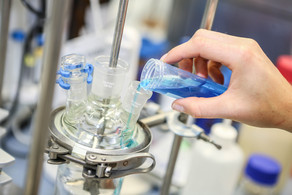Einführung in die industrielle Katalyse
Course Content
This advanced lecture gives an overview of catalysis as a key technology of chemical material conversion and as an important tool within the product compound structures of the chemical industry. The targeted reaction control by catalysts contributes significantly to the efficiency and sustainability of the chemical product compound. This lecture deepens the basics presented in "Chemische Technik 1". After explaining the basic principles of catalysis, these are illustrated using characteristic examples of homogeneous and heterogeneous catalysis from concrete chemical, petrochemical and environmental industrial processes.
Aquired competences
Homogeneous Catalysis
Students will be able to:
- Name the elementary steps in a transition metal-catalyzed catalysis cycle and describe their detailed mechanisms
- Discuss the most important catalyst and ligand influences on the various elementary steps
- Describe and quantify ligand and catalyst properties using common concepts and models
- Identify the rate-determining step for important catalytic reactions
- Make predictions about activity and selectivity
- Explain the principle of asymmetric catalysis
- Name catalyst and process variants for important industrial processes and name and discuss variables influencing activity and selectivity
- List methods for recycling homogeneous catalysts and explain their principles
- Make suggestions for a suitable catalyst and reaction system for an unknown reaction
Heterogeneous catalysis
- Explain the importance of catalysis for controlling material flows in the chemical industry and differentiate between heterogeneous and homogeneous catalysts and compare their advantages and disadvantages
- Describe the use of heterogeneous catalysts in the synthesis of large basic chemicals and intermediates, in refineries, in waste gas treatment and in the food industry with regard to the physical-chemical processes and the applied reactor technology and to name generally valid approaches of heterogeneous catalysis.
Further Details
| Exam | Oral (or written) - 30 (120) min |
| Preliminaries | Admission requirements for the courses of the second and subsequent semesters are defined in § 9 paragraph 7 of the Examination Regulations; the Examination Committee decides on any exceptions in the case of required courses. |
| Literature |
|
Only the information found in the LSF and the most recent edition of the Modulhandbuch der Fakultät Bio- und Chemieingenieurwesen is binding. The content on this page may not reflect the most up-to-date information.






